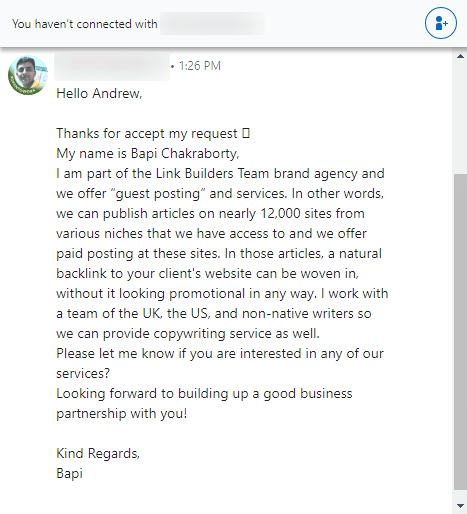There are few things as frustrating as accepting a friend or connection request on social media, and they hit you with it; a sleazy pitch from an untrustworthy and unverified source.

If you’re like most people, you’re hit with “offers” like these every day, another person who wants something from you – your time, money, or attention. We know offers like these don’t work very well. It’s an immediate turn-off; it repels customers, hurts your company’s reputation, and dramatically increases your cost-per-lead.
So why do they do it?
Why do salespeople struggle to close the sale?
If you’re like most people, you know the rules of relationships.
Most of us know it’s a bad idea to propose on the first date; we also see why that’s a problem; building a relationship takes time. It starts off as an interview process, progressively increasing the levels of commitment. Platonic relationships work the same way; Jumping from acquaintance to besties is pretty unlikely.
So why do so many salespeople get it wrong?
Here’s a controversial idea. Salespeople don’t get it wrong. They know how to close the sale, but there’s a long list of bottlenecks that promote the kind of bad behavior we all despise.
Sales bottlenecks that create bad behavior.
- Quotas: There’s a right and wrong way to adopt quotas. Sales reps feel enormous pressure to perform to keep their jobs. They feel desperate if they’re not on track to meet their quota. This desperation produces bad behavior that repels customers and destroys the company’s reputation over time.
- Leaderboards: Many sales organizations rely on leaderboards to identify top and low performers; it’s a shame-based social hierarchy system that’s intended to create intrinsic motivation. Sure, it’s a powerful motivator, but it also produces the kind of desperation that leads to bad behavior. If you’re on top, you’re motivated to work harder to stay there; if you’re on the bottom, you’re desperate to get out. Both groups are incentivized to do whatever it takes to maintain their status.
- Sales commission: A commission-based compensation structure is stressful for average performers who have bills to pay or a family to feed. The surprising part is that a commission structure can also be problematic for top performers; poor financial management means A-player sales reps may be desperate for cash at the end of the month. Generally, top performers don’t want a salary if it’s used as a safety net. Low performers prefer compensation structures that use salary as a baseline.
- Employee reviews: If your sales rep has received a “needs improvement” in their annual review, they may be desperate to score a win. Maybe they want to keep their job, or they’re in the running for a promotion. Whatever their motivation, they must show they have what it takes to perform.
Are these bad ideas?
Not at all; quotas, leaderboards, commissions, and reviews are all important components of a high-performing sales team. The implementation of the policy is the problem, not the policy itself. Any policy, procedure, or workflow that creates sales desperation is a problem.
But why?
Because customers can smell desperation, and desperation is untrustworthy. Customers believe desperate salespeople are willing to say or do anything to make the sale.
At its core, there’s only one reason selling is miserable for customers and salespeople.
It’s fear.
Customers fear you’ll pressure them into buying something they don’t want. Salespeople are afraid customers will reject them, that they’ll lose their job or fail to make the sale. Their desperation is rooted in fear.
What is this fear based on?
It’s a fear of loss. Sales reps are afraid something bad will happen if they don’t make enough sales for their company (they’re usually right). Customers are worried they’ll lose too – money, time, status, etc.
How to eliminate fear and close more deals
Let’s do a little role-playing. Imagine you’re under pressure. You need to make a sale in two days, but you’re negotiating with a single prospect. You have to close that lead to avoid disaster.
How do you feel?
Anxious, stressed out – you’re full of fear, am I right?
Alright.
Same scenario. You have something most customers want. You need to make a sale in two days. You have 63 highly qualified leads. Fifteen of those people are working on signing your contract. Seven have signed your agreement and have sent you a deposit.
Most of these prospects are happy.
Whether you sell to them or not, they know you’re trustworthy, and you care. You don’t really care whether they buy what you’re selling or not. You have so many leads from so many eager people you’re just trying to make sure you help everyone.
Now how do you feel?
Confident, happy, pleased things are going well.
See my point?
Was it the number of leads that relieved your fear? No, it’s much more simple than that. It’s a mindset that governs your ability to close consistently. What mindset am I talking about?
“I don’t need your money.”
This mindset comes from three things (1.) a tremendous amount of quality leads, (2.) a reliable supply of quality leads, or (3.) a proven ability to generate a tremendous amount of leads on demand.
Why does this matter?
If you can produce leads this way, you can overcome your prospect’s unconscious bias. You know the one, the attitude we all have when we’re buying something.
“I have the money, so I make the rules.”
Your prospects only have two points of leverage over you.
- You want/need their money
- You’re afraid you’ll lose them
That’s it.
If you have unshakeable confidence in your ability to identify or generate leads, you instantly fix these bottlenecks and eliminate the desperation most salespeople feel.
What do you need to generate a never-ending supply of leads?
So I’ve already covered the ingredients you’ll need to generate leads.
- A steady supply of fresh, high-quality leads
- The ability to say no, and walk away from a deal at any time
If you have plenty of leads, you have what you need. That’s the question, though, isn’t it? How do you go about generating the leads you need? For starters, you’ll need to identify the type of organization you’re a part of.
- Employer-provided: Your company gives you all of the leads you can handle and then some. You’re scrambling to keep up with the demand, but you don’t have the time you need to do it. This is the HubSpot inbound marketing model.
- Employer-supplemented: Your company gives you a certain amount of leads. If you want more, you’ll need to pay for it, achieve a certain performance standard, or earn it somehow. This is the Glengarry Glen Ross.
- Self-funded: These are the commissioned salespeople who are told to go out and generate new business on their own. These salespeople are expected to do everything – marketing, sales, customer service – on their own. This is the independent contractor model used by real estate agents, loan officers, appraisers, home inspectors, etc.
Here’s how you work with these sales models.
- Employer-provided: Work to solve for X – identifying the fears, risks, objections, and conversion barriers that make it difficult for you to close your deals. If you find persuasive solutions to each of these areas, you’ll be able to increase your conversion rate dramatically. It’s all about addressing bottlenecks ahead of time.
- Employer-supplemented: You’ll need to divide your attention into two areas. (1.) identify and solve for X – identifying and solving customer fears, risks, objections, and conversion barriers. (2.) Amplifying the leads your company gives you, turning 1 lead into 10. You’ll need to create a referral kit for each of your customers (more on this later).
- Self-funded: You’ll need to divide your attention into three buckets. (1.) identify and solve customer fears, risks, objections, and conversion barriers. (2.) Amplifying the leads your company gives you, turning 1 lead into 10 via referral kits. (3.) Use feeders to send you a steady supply of cold or warm prospects that you warm up.
Still with me?
Okay, here’s how you implement each of these steps.
- Solve for X to close more deals: If you’re going to identify and solve customer fears, risks, objections, and conversion barriers, you’ll need data. You’ll need data from your tools of choice. If you’re using a CRM tool like Pipeline, you can filter your lost deals by loss reason. You’ll also want to reach out to your marketing and customer service teams for more intel. Work to create a list of these reasons, then, working with your managers, create a persuasive solution to each of these problems. If they already have a solution, implement that.
- Amplify leads with a referral kit: Amplifying the leads your company gives you turns 1 lead into 10. You’ll need to create a referral kit for that. A referral kit is a printed educational booklet. These published educational pieces (a.) outline a prospect’s specific problem in one area (e.g., finding trustworthy, low cost, high-quality manufacturing) and (b.) lead prospects to a specific, free, very helpful solution (online or offline) that addresses this problem. These referral kits send prospects to a URL where their contact information is collected and sent to you, the sales rep. The URL could be a free download, tool, webinar, video, workshop, or guide.
- Use feeders to generate leads on-demand: Feeders send you important must-have information. These could be complementary sources that send you leads in exchange for content (e.g., realtors sending mortgage broker leads in exchange for free training and content). Listings on specific sites (e.g., Indeed, Zillow, Realtor, etc.) or leads generated via paid ads + a Facebook group + education/special offers (paid ads can be done for as little as $10 per day). You can generate a consistent amount of leads using feeders and education as a compelling bait piece. The formula is simple; it’s (feeder + irresistible offer + landing page = leads)
Here’s a short list of the various types of feeders you can use to generate leads.
- Paid advertising (e.g., Google Ads, Facebook Ads, Yelp Sponsored Listings, LinkedIn Ads, etc.)
- Listing websites (Glassdoor, Indeed, Monster, etc.)
- Complementary sources (e.g., partnerships with industries around yours – Food Samples + Costco)
- Forums and groups (i.e., Reddit, Facebook Groups)
- Q&A sites (i.e., Quora, Stack Exchange, Reddit)
- Media (e.g., YouTube, Podcasts, audiobooks)
- Social media (e.g., Facebook, Twitter, Telegram, Snapchat, Pinterest, etc.)
- Partnerships (e.g., joint venture partnerships, strategic alliances)
Feeders are a traffic-getting source.
Sales traffic comes from two sources; (1.) organically developed traffic you build on your own. (2.) traffic you borrow or (siphon) from other sources.
This is how you close deals effectively.
Closing deals effectively begins by conquering your fear
No leads, more fear. More leads, less fear.
As we’ve seen, closing deals effectively comes from a willingness to walk away. Your ability to walk away comes from three areas: (1.) a tremendous amount of quality leads, (2.) a reliable supply of quality leads, or (3.) a proven ability to generate a tremendous amount of leads on demand.
Access to leads counters your prospect’s unconscious bias.
“I have the money, so I make the rules.”
Your prospects only have two points of leverage over you. You need their money, or you’re afraid you’ll lose them. Use the feeder method, and you’ll find you can close more sales, turn 1 lead into 10, and generate an unlimited supply of leads. With consistent effort, you’ll find you can close more deals consistently.
18,000+ Businesses use Pipeline to close deals effectively.
Pipeline CRM helps companies like yours decrease time-to-close, increase productivity by 50% or more, and boost sales by as much as 10x. Don’t take our word for it; let us show you how Pipeline can help you attract, win, and retain customers. Explore our CRM features and industry-specific solutions.



